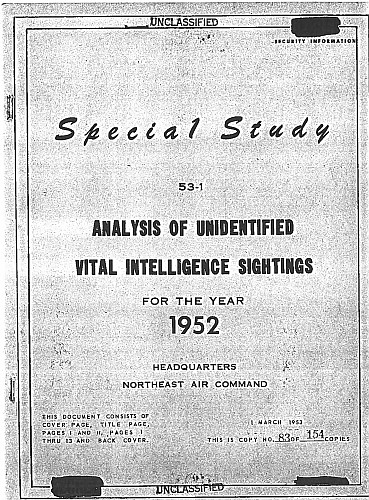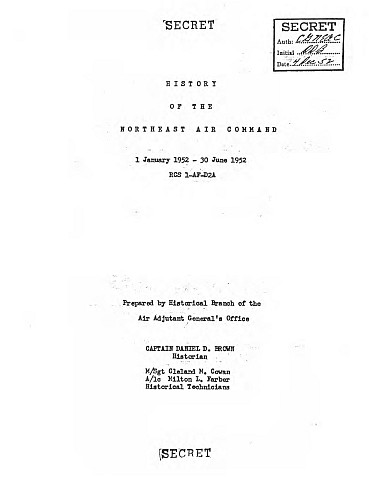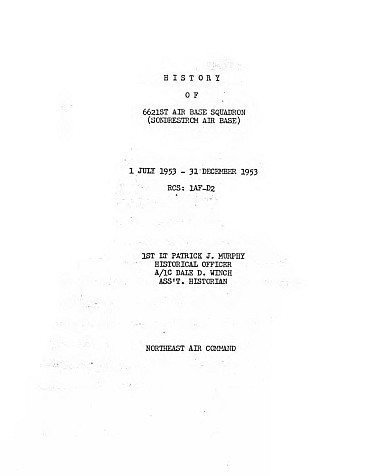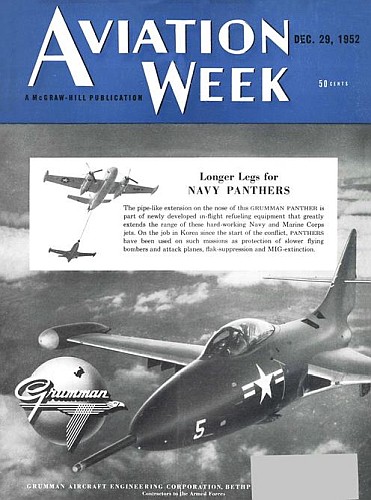Convair Division, San Diego, California)
ALTITUDE AND HOVER IN SKY
Two Convair pilots, flying freight from San Diego to Fort Worth late last month, had something to talk about during the last quarter hour of their flight.
Pilot Loran Pilling didn’t come out and say he'd seen a “flying saucer” but did indicate that he had seen something he couldn't explain. Neither could co-pilot Russ Fishback explain it.
“It looked like the landing light of a plane and was at maybe 5,000 feet, ahead of us. We were at 3,000 feet. It was about 9:25 p.m. when we sighted it and we never got close enough to see a shape.”
Whatever it was could climb at a high rate of speed for later it raced up to 20,000 or 25,000 feet, and also could hover, for it seemed to hang in the air. On landing at Fort Worth Pilling found he and Fishback weren't the only ones to view the phenomenon.
The field tower had been watching too.
“Don't ask me what it was," Pilling said, “I just know I saw something.”
6338 Colonial Dr.
Boise, Idaho 83705
February 26 , 1971
Dear Mr. Cerny
I first observed this light a considerable distance ahead. It was perhaps a bit more prominent than any others when first observed. After several minutes I suddenly wondered why we hadn't reached its position.
When I began concentrating on the light I realized it was not attached to the ground. I had seen the Military drop flares during night maneuvers in the past. About that time I was confused and commented to Lauren Pilling who felt it was a very unusual light also: unusual because it was definitely not on the ground and yet not settling as a flare would do.
About this time we were suddenly aware that we were approaching it (the light) which for the first time changed its position by moving toward the right of our course, at about our altitude. The rate of closure was suddenly very rapid. We did a very steep right-hand turn to follow the light which had begun to climb rapidly and pass toward our right rear. It began a very rapid climb to many thousands of feet, where it appeared to stop again.
We finished a 360 and proceeded to Fort Worth, our home base. Shortly thereafter we called our operations radio at Convair-Fort Worth and advised of our estimated arrival in about 15 or 20 minutes. At this contact I recall our Convair employee asking if we had seen any "flying saucers".
This certainly proved that we had seen something. I believe he also added that the light was seen by tower personnel and two F-86's were dispatched but the light was not caught up to by them.
I looked at the light very carefully at our closest point but could not make out any shape. There could have been two flames being emitted. I was in the right seat, it was a clear but dark night. The only maneuver it appeared to make was: motion was commenced toward the east and at right angles to our course. Its course appeared to change to a right turn and a climb as we got within relative close proximity. Originally the light appeared to remain in one place.
I have never seen anything like this prior or subsequent to the incident described above.
Hope this will be of some value to you. It is all I am able to provide.
Cordially,
(Signed) Russ Fishback
Says Top Physicists, Military Experts
They're real....they're Red.....and they're American too!
Flying saucers are guided missiles, both American and Soviet. The inescapable conclusion from world-wide reports is that the Red saucers are launched from Atomgrad No. 3, a heavily-guarded missile center in a barren waste near the Finnish border. Swedish authorities have detected their passage as they hurtled across Scandinavia in a direct line for this hemisphere. Other Red launching sites are in Siberia.
The Soviet missiles are crewless, between 50 and 75 ft. in length, about 14 ft. deep. Rockets provide their main power source but they also carry auxiliary motors, possibly jets. Ovoid in shape, they reach altitudes of 80-100,000 ft., attain speeds in excess of 2,500 mph.
Loaded with cameras and electronic observation devices, the missiles seem to have but one mission at present — to reconnoiter U.S. atomic and military installations. They could as easily carry atomic warheads.
The Soviet missiles are remote-controlled. Red submarines, posted strategically in a chain across the Atlantic, are equipped with electronic monitor boards to guide the missiles through each sub's "control area." Thus, a missile originally launched on a course that would place it over Washington, D.C., may be diverted by a sub off Nova Scotia (where unidentified subs have been reported) to a course aimed at the Brookhaven Laboratories on Long Island, close to Manhattan.
The Red saucers need not return to base to deliver their reconnaissance data. Their findings, including aerial photos, automatically beamed to a sub or other secret station, are reproduced and delivered to intelligence headquarters in Moscow. To prevent its falling into non-Red hands, each missile carries a high-explosive destructor charge which can blow it to bits the instant a button on the sub is pushed.
The Soviet long-range snorkel submarine program for guided missile work was reported by Allied intelligence as far back as '48. These subs, developments of the Germany type XXVI, which had a 1,160 ton displacement, can cruise under water at the phenomenal speed of 24 knots and remain submerged indefinitely.
For 36 months the U. S. has been working frantically to keep ahead of Russia in the guided missile field. Dr. Karl Compton, one of the nation's great scientists, has envisioned huge, crewless missiles screaming through the ionosphere 6,000 mph. Said Dr. Compton in 1949: "...the picture of smashing a vital electronic development on the outskirts of Moscow from a launching pad somewhere in the United States in not pure fantasy."
Today, U.S. rockets are being launched from the Joint-Services proving grounds on Cape Canaveral in Florida. These rockets carry electronic devices, can carry atomic warheads. Should one go out of control, a scientist at the base bits the "destructor button" on his control board and an explosive charge in the rocket blows it up. Military authorities will admit that flights of as long as 500 miles have been made by these guided missiles over the Caribbean. Reports of saucers and other mysterious "objects" sighted in this area frequently refer to these missiles. Our officials aren't worried about these reports. They are jolted, however, by the 400-odd "unexplained" saucers and fireballs which have crisscrossed our skies, appearing in their biggest concentrations over vital atomic and defense centers.
"Of course flying saucers are real," declared a regular U.S. Air Force officer stationed in New Mexico. "They are not mass delusions. Don't be sucked in by denials in publicity used to cover up AF investigations. Flying saucers are regularly seen over Los Alamos." During WW II, U.S. pilots in Europe and in the Pacific reported glowing globes, mostly green, which followed their planes at fixed distances, made no hostile moves. They just "seemed to watch," pilots reported. Intelligence took it seriously.
In 1945 following detailed reports by B-29 crew flying missions over Honshu, the 21st Bomber Command's intelligence officers decided that the fireballs were remote-controlled guided missiles. Recently, fireballs have been seen over Korea, Alaska and the southwest U.S. The Pentagon is particularly disturbed because they resemble American developments which were considered exclusive and top secret.
Attempts to pass the fireballs off as meteors were spiked by Dr. Lincoln LaPaz, head of the Institute of Meteorics at the University of New Mexico. "I have never seen a natural meteor with the characteristics of the yellow-green fireballs," he told People Today. "Meteors blow up with a loud explosion. These disintegrate with complete absence of sound. Sightings here and in Scandinavia lead me to believe that fireballs and the so-called saucers may be guided missiles -- some possibly ours, some possibly Russian. In any case, they are Earth-born.
"It is possible that the yellow-green fireball is not the missile itself but the remaining part of a missile in the final phase of self-destruction. It does not explode -- it simply evaporates in a flash of light."
Said Dr. LaPaz: "Compare the saucers with the atomic bomb. If someone had asked a Manhattan Project official for an explanation of the brilliant mushroom of light at Alamogordo, he would have received a blank stare and been told that no such thing ever happened."
By Mysterious “Object”
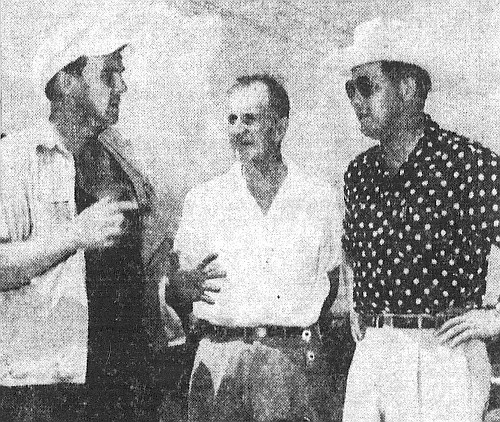
Miami Daily News Correspondent
Red, Amber Lights
Acrid Odor
No Explanation
Interview of Fred Brown, by George Wolfer and Bill Nash on April 9, 1954
George Brown is respected by his work-fellows and superiors to whom we talked first. He is forty-five years old, approximately, honest faced, sturdy farmer-type who doesn't waste words, but tells a straightforward story of his experience. He offers no explanation for what the thing was. Won't call it a saucer. He served four years and 8 months under General Patton, and says he doesn't scare easily, but felt shaky for a couple of days after the experience.
The experience is as in the clipping, with the additions that the cows dropped off in milk production from 15 gallons to ten gallons for the next 3 days and didn't fully recover for 3 weeks. Also the horses in the field broke down a corner of the fence, and a gate of another fence, and it took all day to get them back. Neither the cows nor the horses wanted to return to the area.
40 feet, were on the bottom of the rim of the thing (which was silvery and convex on the bottom), and the lights were about fifty to sixty in number, alternately amber and red.
He said that he forget all about a 30-30 rifle he had in the barn, or he'd have taken a shot at the thing. (Glad he forgot!)
His address is 311 S.W. Main St., Belle Glade, Fla. Phone - 3063.
Some workers who arrived later than he did on the job asked him what he’d been spraying with, and he told them about the strange machine which emitted the a(m)monia like odor and sounded like shorted-out high tension wires in the morning dew.
Both the Army and Navy questioned him the next day, and when he asked them questions in turn they told him that they were there to ask questions — not to answer them.
George and I were impressed with the integrity and sincerity of Fred Brown. We photographed him on the spot of the occurrence and tape-recorded his story.
Note:- Fred Brown said that he could only hear the low humming sound when the saucer was close to him, but that there was no sound when the object sped away at a great rate.
Two Young Men Make Startling Discovering (sic)---
Notify Air Force
The young men, Raymond Sharkey, 20 Birchwood road, Methuen, and Robert Sullivan, 61 Arlington street, hurriedly advised authorities at the Westover Air Force Base in Chicopee of their observation.
Sullivan said that the "saucer," which he described as elliptical in shape, made no noise in its flight which appeared to be sideways. "In fact," he said, "it looked like a little white cloud and was flying at a terrific rate of speed.
"It was flying very high and we were able to observe it for about ten seconds before it disappeared from our view over one of the tall buildings. It was heading north.
"We just can't believe it. I was skeptical once, and thought it was a reflection people saw but I've changed my mind now," Sullivan declared.
"Flying saucer sightings and movements."
The Air Ministry said it was investigating a report of a silver-colored circular object moving through the sky about 15,000 feet up at a speed faster than a shooting star.
During the brief glimpse -- between 15 and 30 seconds -- the object was reported to have switched its course and then seemed to descend.
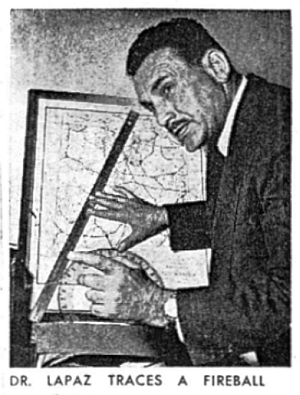 ALBUQUERQUE, N. Mex.– Any discussion of the remarkable “green
fireballs” so frequently observed in recent years in the Southwest
must begin with an appraisal of the accuracy of eyewitness accounts
of these objects. Admittedly, the majority of fireball reports
relate to ordinary meteoric phenomena, although those reporting
usually believe they have sighted something strange.
ALBUQUERQUE, N. Mex.– Any discussion of the remarkable “green
fireballs” so frequently observed in recent years in the Southwest
must begin with an appraisal of the accuracy of eyewitness accounts
of these objects. Admittedly, the majority of fireball reports
relate to ordinary meteoric phenomena, although those reporting
usually believe they have sighted something strange.
When sighted by one of the women about 4:20 am in the southeast sky, it was at first thought to be a "very bright harvest moon."
However, this person realized quickly that it was too bright, and also much out of place in the sky at that time of morning to be a "harvest moon."
It was about this time the viewer realized it was a round object, with blinking lights around its lower part.
Although there was a ground haze in the area, the person reported the lights flashed red, green and amber, blinking alternately.
The sphere moved up and down and from side to side, remaining in the southeast throughout, and being watched about 25 minutes before disappearing in the same direction.
A few minutes after its disappearance, it reappeared again, but not as near, one observer saying it "looked four or five times larger than a star."
However, at the (sic) distance, the lights, still blinking alternately appeared red, green and white, the amber missing and the white an addition.
It moved from side to side, also up and down, staying in its southeast position about 15 minutes before finally disappearing for good.
Five persons in all witnessed the "flying object," the others being called by the first to observe it, but none was informed of what was seen in the sky.
The group is well known at the Station, located on Six Mile Rd., three miles from Belle Glade. None wished use of his name.
Over Fairfax
"It beats anything I ever saw," said Pvt. Julian Burke. "l don't know what they were. It wasn't my imagination because other officers saw them and we were all dead sober."
The "flying saucers" were reported by Mrs. F.L. Hazelwood, who lives on Route 645, about one mile South of Centreville. Pvt. Burke, investigating the report, said he watched the objects from Mrs. Hazelwood's house for an hour.
He said he saw four at one time. He described them as round, orange-colored objects, about as big as a three-gallon bucket. He said it was very foggy and the objects appeared to be darting in and out of clouds.
He said when he first arrived at the Centreville home the objects were closest and appeared to be about 2,000 feet away. In his description, the officer said the balls would appear first as a small light and then get big as they seemed to get closer. They disappeared in the same way, he said.
When the objects would disappear from sight, he said, they still made a white light for a while like a car light shining through the fog, except that they were "very bright."
He said Sgt. John Wahl also came out to investigate after he radioed back his observations. Burke said he and Wahl watched the objects together for about 20 minutes.
They returned to the police station about 2 a.m. There, he said, they saw another similar object. This time it also was watched by Pvt. Marvin Harrel, desk officer on duty at the time, and two other officers on the night shift, Pvts. Dunn and Lloyd.
Meanwhile, police had notified the control tower at National Airport of the objects shortly after 1 a.m. The tower reported that they could not pick up anything on the radar scopes, nor could they see anything. A Civil Aeronautics spokesman said an American Airline flight passed over Springfield in Fairfax County about the time the "saucers" were reported but the plane couldn't make the type light described.
The Naval Observatory in Washington this morning said it had no reports of any unusual lights in the sky last night. A spokesman said a meteor would probably be an orange color but that meteors can be seen only for a few seconds and wouldn't act like those described by police.
Burke said the object seen at the police station disappeared in the direction of Washington. After the last one had disappeared police reported the objects to the Department of Defense on instructions from the airport control tower.
Mrs. Hazelwood says the saucer had a strange smell that made her husband think something was cooking in the backyard.
From Mysterious Balls of Fire
Police Corroborate Resident's Report
Of Strange Objects in Night Skies
Four Fairfax County policemen sighted the objects when they went to investigate a report of a resident of (sic) near Centreville that she had seen strange lights in the sky.
Police Pvt. Julian Burke described the sight this way:
"They came out of the clouds like headlights, then brightened up all at one time."
There appeared to be three or four bright objects, he said, "going in and out of the clouds."
With him were Sergt. John Wahl and Pvts. Richard Lloyd and Douglas. They had gone to investigate "several big balls of fire" reported by Mrs. F. L. Hazelwood of Route 645, about a mile south of Centreville.
The objects were visible for more than three hours, the policeman said. They were viewed between 12:50 a m. and 4 a.m.
Pvt. Burke said over the Centreville area the objects seemed fairly close to the earth and "bright enough to light the ground." Later, when the policemen returned to Fairfax, the objects appeared to be directly above the police station and high in the air.
Officials in the control tower at Washington National Airport, apprised of the report, scanned the skies and their radar screen. They said they saw nothing. An airplane was in the area at the time, they said. But, they added, this was for a short time only.
Andrews Air Force Base officials reported no unusual "blips", on the radar screen there.
Fort Belvoir, where Army physicists have created glowing rings in bell jars, said no experiments were being conducted early today. The engineer post also ruled out the searchlight possibility, asserting that its lights had not been in use since Friday night.
The Fairfax County police said that when the objects last were sighted about 4 a.m. they appeared to be headed toward the District.
The first of numerous calls to police was made by Mrs. Hazelwood, who complained her yard was filled with bright lights and a vile odor.
Mrs. Hazelwood's daughter Marie told Fairfax officers the odor made her mother ill and was bad enough to make her father get up and go out to see if anything nearby was burning.
"NOT IDENTIFIABLE"
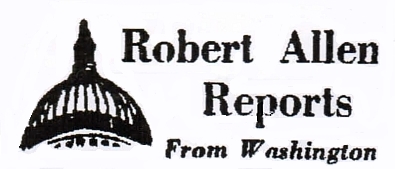
Military authorities said yesterday that the object hovered over the base last Monday night. The information at first had been classified as confidential.
Eight soldiers said the object was about 200 feet across and trailed red-orange sparks. It circled rapidly and sometimes hovered, they reported.
Mrs. Arthur D. Benson, supervisor of ground observers at Dover Plains, said ten ground observers saw the objects in the sky the night of September 11th near the Connecticut border.
She described the objects as "flashing on and off" -- a greenish color with red flash.
She said she called the civil defense information filter center at White Plains, which advised her to hold the line open to give a running report while a jet plane was sent to investigate.
Mrs. Benson said when the plane appeared the objects changed to a bluish color and disappeared.
CAMP DRUM INSTALLATION
Military authorities said yesterday an unidentified object zoomed through a half hour of weird aerial gyrations over this base last Monday.
The incident was classified as confidential military information until yesterday.
The object was described by camp officials as 20 feet in diameter with an exhaust tail of reddist (sic) orange sparks.
Eight soldiers who saw the object reported it sounded like the whine of a generator or rotating disks. Griffis Air Base at Rome was notified of the incident immediately, officials stated.
The observers said the object hovered, circling rapidly, and occasionally stopped completely.
Noticed at Midnight
Air Force officers from Griffis Base questioned the men about characteristics of the object the next day.
The Air Force would not comment.
people who reported seeing a group of glowing objects cross the night
sky in eastern N.S.W. at fantastic speed last week?
DID you laugh over the reports a few weeks before from the conference of the Australian Flying Saucer Research Society at Ballarat? Not I. Because I have seen a flying saucer — or rather, a cigar-shaped unidentified flying object.
No, I am not “nuts” — or if I am, there are about a dozen other people crazy with me. Because they saw the same UFO.
My sighting was so vivid and unnerving I have never forgotten the place and time — over the Adelaide Hills of South Australia at 9.44 p.m. on October 18, 1952.
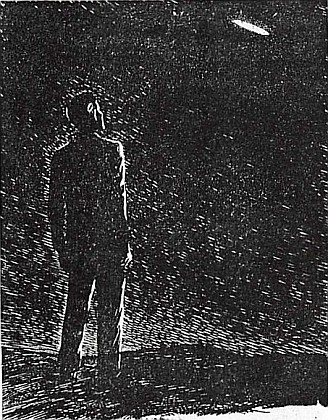 Returning home from an assignment for the Adelaide “Advertiser,” I
saw against a clear dark sky a greenish-white iridescent cigarlike
object, about the size of a Boeing 707 seen about 10 miles distant,
moving from left to right across my front and from south-east to
north-west.
Returning home from an assignment for the Adelaide “Advertiser,” I
saw against a clear dark sky a greenish-white iridescent cigarlike
object, about the size of a Boeing 707 seen about 10 miles distant,
moving from left to right across my front and from south-east to
north-west.
At first I thought it was an airliner, then I remembered that it was too late for one to be up.
And this aircraft was one long light—and emitted no sound.
In that instant I felt a shiver pass through my, body — I knew that what 1 was looking at was not “natural.”
I stopped still to watch, and as I watched the thing made a sudden right-angle turn upwards and vanished, slowly at first then at tremendous speed.
Immediately on arriving home I told my wife what I had seen — she had remarked that I looked white and shaken — and I telephoned Adelaide Airport control tower which told me there was no aircraft in the-air at that time.
Next afternoon when I reported for duty I told the, “Advertiser” deputy chief-of-staff, Mr D. Jervis, I believed that I had seen a flying saucer the night before.
He laughed, and I did not blame him. It had been Saturday night. He reminded me my assignment had been in the Barossa Valley — South Australia’s famed winegrowing area.
I thought perhaps J might have been “seeing thing,” as he hinted.
He was not laughing at me an hour later, however.
By then The “Advertiser” had received a number of reports from people who claimed to have seen a flying cigar between 8 and 10 the night before.
The reports came from as far south as Coonalpyn, on the Adelaide-Melbourne railway, and as far north as Port Pirie.
This placed the sightings all on a south-east/north-east line.
A few days later I had a telephone call from the then S.A. Government Astronomer, Mr G. Dodwell, who asked me to visit him and relate what I had seen. He had contacted several of the people who claimed to have seen the UFO, got their stories, then contacted me because, he said, a reporter should be able to give a more accurate account than a layman.
Mr Dodwell and I spent an hour together in his observatory on West Terrace during which he questioned me thoroughly — often going back to repeat a question to find out if my answer varied.
Our meeting was at night and we went outside where he made me demonstrate what I had seen against the sky.
Eventually he told me that—
• What I had seen was indeed a moving object and could not—because of the Saturday night conditions — have been a light reflected from the earth.
• The object had been travelling on a magnetic course.
• When I first saw the UFO it would have been travelling about 200 m.p.h., but when I last saw it it had accelerated to 72,000 m.p.h. (By Mr Dodwell’s calculations, my entire sighting had lasted no longer than five to seven seconds.)
Mr Dodwell — recognised as one of the most able astronomers Australia has produced — also told me, but asked me to keep his confidence (a promise I no longer feel bound to hold, for he died some years ago), that he was convinced that flying objects from outer space did exist.
He said, his research indicated that they had been visiting the earth for centuries.
Much literature told of strange objects seen in, the sky which could be attributed now because of man’s awareness, only to visitations from beyond the earth’s atmosphere.
Since then I have never doubted that UFO are real.
Seldom have I related the happening of, October 18, 1952, because whenever I have, the reaction has been obvious. And believe me, I was not drunk that night.
Certainly, had I been, what I saw would have sobered me quickly.
I shivered then. Recalling it now sends a chill down my spine.
Seeing Strange Phenomena
Washington—A Navy pilot, chasing a cosmic ray research balloon last August over Greenland, saw some strange "phenomena," the Navy said Friday.
Cautiously refraining from using the words "flying saucers" and noting that it had little data on the "phenomena," the Navy released the following statement: "About 5 p.m. on 29 August, an 85-foot-diameter balloon carrying a neutron counter from New York University started floating at 90 thousand feet, and had settled to 74 thousand feet when the parachute carrying the instruments was released by a timing device.
"As the parachute floated away from the balloon on its way down, the pilot of the Navy tracking plane observed three phenomena, which appeared to come out of the balloon and moved toward the sun in the opposite direction to the parachute. The phenomena were observed for about 30 seconds.
"The pilot was Lieut. John Callahan, Patrol Squadron 23 of the Thule (Greenland) detachment. When the parachute was released, the balloon would have an excess free lift and should move vertically at an increased speed which would cause turbulence in the air.
"This may have resulted in the reflection of sunlight and caused the apparent phenomena."
The Air Force last August advanced the theory that some of the "flying saucers" being reported at the time were reflections of light rays, or other radiations, against layers of air of different temperatures.
The Navy report from Greenland suggested that the apparitions
Lieutenant Callahan saw were caused by similar reflections of
light against the turbulent air.
Of 'Flying Saucer' Reports
Eleven reports of flying saucers in the Hawaiian area have been investigated by the Air Force since July 7, 1947, and all but one of them has been attributed to known causes.
Altogether, the Air Force said, mysterious disc-like spheres have been reported 24 times in the Pacific and Far East since an unknown person at Hickam Village first described seeing one more than five years ago.
At the request of The Star-Bulletin, the special section of the Air Force evaluating reports of the saucers compiled the record of sightings in the Pacific and Far East.
Of the 24 reports. 10 of them were of daylight sightings, while 14 observers said they saw the discs at night.
The only Hawaii sighting which the Air Force evaluators could not explain was made last July 16 by crewmen of the submarine Bugara off Lahaina, Maui. Men who saw the phenomenon through binoculars said in a report that an oval disc that varied in color from white to red as it moved across the sky.
In forwarding its compilation, the Air Force noted that “no photographs (of mysterious flying objects) are available from your area.”
Other Pacific sightings were reported from Wake, Midway, Clark Air Force Base in the Philippines, eight airplanes and one merchant ship.
Accompanying is the Air Force’s record of the 11 reports made in Hawaii.
| Saucer 'Sightings' in Hawaii | |||||
| PLACE | DATE | BY WHOM | DESCRIPTION OF OBJECT |
HOW OBSERVED | EVALUATION |
| Hickam AF Base | July 7, 1947 | Unknown | Silver, spherical object | Visually from ground | Probably balloon |
| Honolulu | Oct. 19, 1948 | Air Force pilot | Bright silver disc | Visually from ground | Probably balloon |
| Hickam AF Base | Jan. 4, 1949 | Air Force officer | Brilliant white disc | Visually from ground | Probably balloon |
| Hickam AF Base | Dec. 24, 1950 | Sergeant and civilians | White-orange tail | Visually from ground | Astronomical |
| Hawaii |
Dec 25, 1950 | Air Force pilot | Orange flame | From the air | Astronomical |
| Honolulu | Jan. 8, 1951 | Civilian | Orange colored flame | Visually from ground | Astronomical |
| Lihue, Kauai | Jan. 18, 1951 | Civilians | Silvery disc | Visually from ground | Probably balloon |
| Lahaina, Maui | July 16, 1952 | Submarine personnel | White-reddish oval disc | Visually from surface (binoculars) | Unknown |
| Honolulu | July 29, 1952 | Navy officers and others | White object | Visually from ground | Balloon |
| Hickam AF Base | Aug. 4, 1952 | Civilian | Two cream colored plate-like objects | Visually from ground | Possibly aircraft |
| Hickam AF Base | Aug 19, 1952 | 4 civilians | Round, shiny, metallic object | Visually from ground | Probably balloon |
Excerpt from Loren Gross, Fifth Horseman of the Apocalypse,
Supplemental Notes for November-December, 1952, page 14-16
Currently there is no complete breakdown of all the programs ATIC might have initiated in the fulfillment of this mission. However, the following documents reveal various projects and research into advanced photographic techniques and the installation of gun cameras on F-86 jets in an effort to try to capture the "flying saucers" on film.
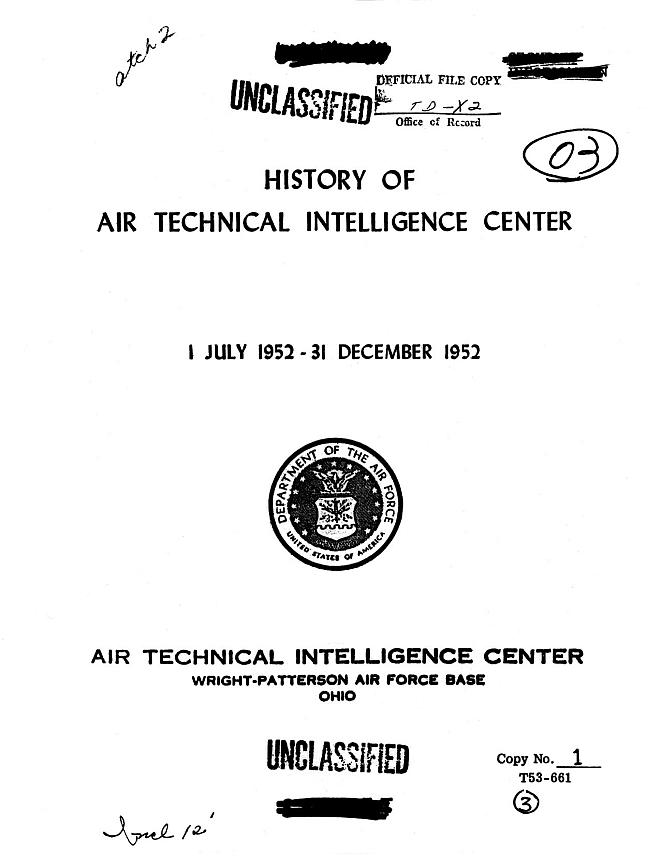
|
ORGANIZATION: The Office of the Chief, ATIC, is composed of the
Commanding General, the Deputy Commander, the Executive Officer and
the Assistant to the Chief. The staff consists of the Inspector
General, the Scientific Advisor, the Air Intelligence Officer and
the Policy and Management Officer. Subordinated to the Inspector
General are the Internal Security Section and the Office of the Air
Inspector. Similarly subordinated to the Policy and Management
Office are the Personnel, Comptroller and Air Adjutant General
Branches.
FUNCTIONS: The functions of the Office of the Chief,
ATIC are to accomplish the air technical intelligence phases of the
overall mission of D/I USAF, as follows:
To provide air technical and scientific intelligence services
for USAF as required to prevent technological surprise from any
source;
To produce air technical and scientific intelligence studies
and estimates of alien capabilities to conduct aerial warfare;
To provide basic data on foreign air weapons and related
materiel, necessary in the production of recognition manuals and
performance handbooks;
To nominate, indoctrinate, train and provide technical
guidance for ATLO's as required for the Air Attache system, and as
required for various overseas Commands;
2
To conduct technical orientation and specialized training of attache
personnel prior to their departure for foreign duty;
To indoctrinate selected Air Force personnel in the
techniques necessary to conduct air technical and scientific
intelligence operations in the field;
To investigate and analyse reports of unidentified aerial
objects or of phenomena of possible concern to the air defense of
the US;
To provide administrative services for WADC and AMC for
their foreign scientists' program;
To provide air intelligence for AMC, WADC and certain
components of ARDC;
To disseminate intelligence information concerning foreign
air technological and scientific developments required by USAF
research and development program;
To provide, as required, D/I USAF representation on Air Force
and Joint boards and committees concerned with technical and scientific
intelligence;
To establish requirements for air technical intelligence
information, data and material and to provide technical guidance to
collection agencies;
To participate in certain phases of the domestic exploitation
program of other intelligence agencies as directed;
To provide limited translation services to D/I USAF, WADC,
CADO and AMC upon request;
|
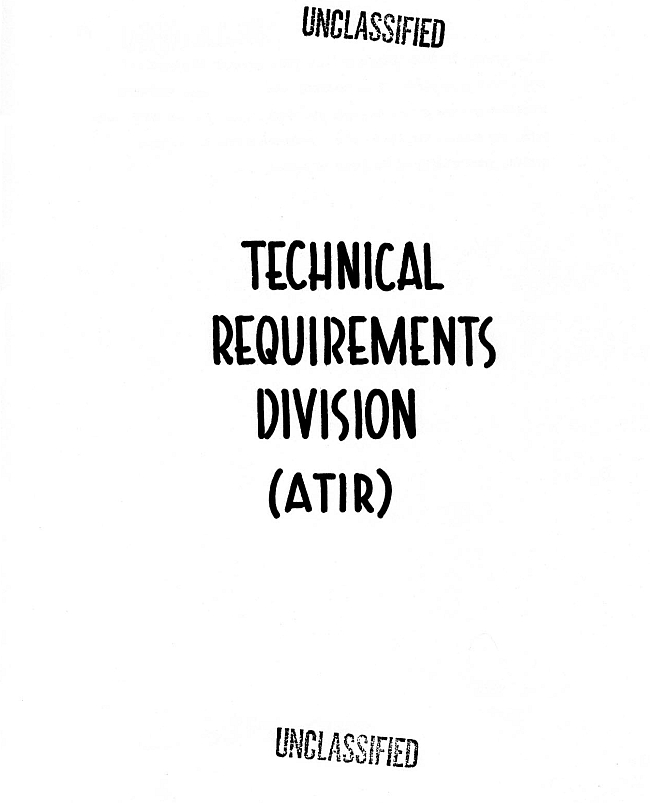
|
39
A proposal was submitted to consider use of US exchange
officers for ATLO duty in England. The exchange officers, because of
their knowledge of specific fields, were believed to have superior
experience for service in the ATLO field.
Through the efforts of ATIR-2, the installation of gun
cameras in F-86's assigned to the Fighter Squadron at
Wright-Patterson Air Force Base was assured. The purpose of these
installations is to provide suitable photographs during flights
resulting from reports or sightings of unidentified flying objects.
Steps were taken to insure that complete and continuing
information covering a wide field of subjects and sources would be
automatically forwarded to ATLO's. The type of information to be
furnished would include knowledge of new equipment useful in
collection of technical information, references to collected
information from other sources, and information assisting ATLO's in
the performance of their functions.
Arrangements were completed with the Air Information
Division, Library of Congress, for the collection of Soviet
biographical data and for the fullest utilization of the Library in
support of the air technical intelligence information effort.
Valuable contributions by the Library of Congress have already been
made to the air technical intelligence collection effort.
|
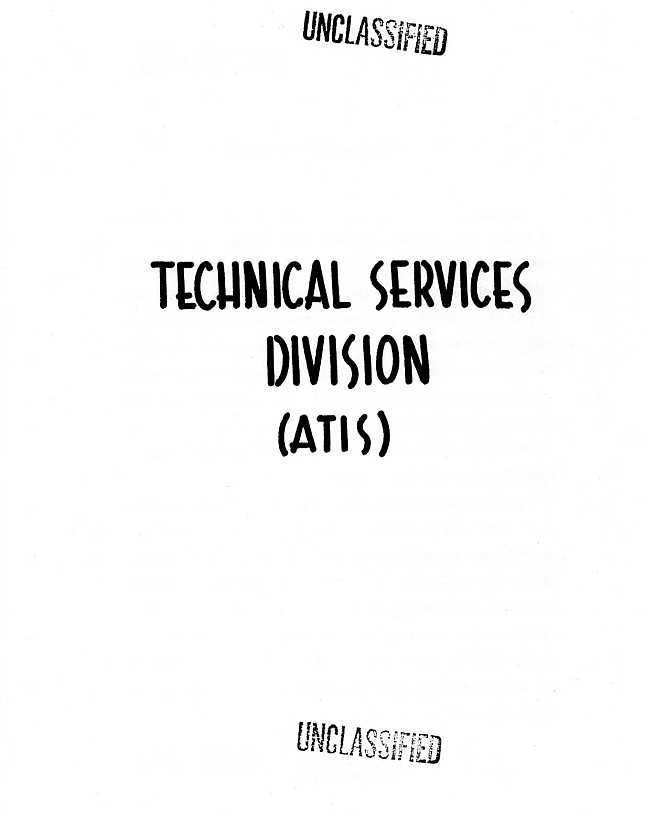
|
50
specialized training in the fundamentals of photography and in the
various photographic media applicable to the collection of technical
intelligence. These included 15 officer Air Attaches, 10 airmen, 27
ATLO's and 37 investigators.
Photographic research was carried on to determine
inexpensive equipment by which photographs of unidentified flying
objects and possible radiant energy therefrom could be recorded in
silver or dye densities in the form of a spectral image with a
single exposure.
Also conducted was a survey of available film
emulsions and sensitometric studies to determine the film and
developer combination with characteristics most suitable for
recording a usable spectral image of unidentified aerial objects.
An optical system for laboratory testing of replica
diffraction gratings was fabricated under simulated practical usage
for an infinite object. Using this system, 100 replica diffraction
gratings were tested to determine photographic effectiveness.
A technical report entitled "A Fine Grain 35-mm Low Contrast
High Speed Film Emulsion Developer Combination", was prepared as a
result of extensive research and experimentation. The report showed
that the effective emulsion speed of Kodak Super XX could be
increased two to four times.
The Orientation and Indoctrination project continued to show
progress. A part of this program is devoted to airman assigned to
the Center who are given an "Information and Education" course. This
function was delegated to the Center by the Base.
53
FUNCTIONS:. The functions of this division are to produce
finished air intelligence; to assemble and maintain working files of
technical and scientific data essential to accurate continuing
appraisal of foreign aeronautical equipment; to provide such basic
data on foreign air weapons and related material as necessary to the
preparation of recognition manuals and performance handbooks; and to
produce technical reports of observations of unconventional aircraft,
missiles or of such other airborne objects as might indicate
an advance in technological knowledge by a foreign power.
The operations of the Division were more specifically defined
in D/I USAF Office Memo, Number 22-5, dated 30 September 1952. The
Memo stipulates that the functions of this division are to produce
finished air technical intelligence; specifically, to analyse
research and development, design and construction, processes of
manufacture and performance of ground and airborne weapons and
material pertinent to air operations of foreign nations in order to
meet ATIC mission objectives and satisfy all using agencies; to
assemble and maintain working files of technical and scientific data
essential for a continuing appraisal of the capabilities of foreign
aeronautical equipment;
54
to maintain liaison with other governmental agencies on air
technical intelligence matters pertaining to the production of oral
or written reports, briefs, estimates and studies necessary to
fulfill Air Force Intelligence requirements; to provide basic data
on foreign air weapons and related material necessary to the
preparation of recognition manuals and performance handbooks; to
prepare air technical intelligence publications as required; to
compile data on certain aspects of atomic energy, and biological and
chemical warfare.
BW, CW and AS will be limited to technical considerations related to
weapons development such as atomic power plants and the
incorporation of warheads with the vehicle. Excluded are BW and CW
agents and nuclear material.
ORGANIZATION: The Special Studies Office (ATIA-4) was
abolished during this reporting period. As of 31 December, three
offices remained: the Administrative, Plans and Operations, and
Technical Advisor. The division, in addition to the offices,
consists of three branches: Aircraft and Propulsion (ATIAA),
Electronics (AT1AE), and Associated Equipment (ATIAS).
Pending at the conclusion of the reporting period was a
proposal to reorganise this division to effect a more equitable
distribution of the work load among the Division's three Branches. A
Staff Study, dated 24 December, was prepared which recommended
certain organisational changes and which was subsequently endorsed
by the Commanding General.
Analysts are divided into three Branches: Aircraft and
Propulsion (ATIAA);
|

|
70
The principal difficulty encountered was that of determining
the radar echo area of selected US aircraft at 73 Mc. This was overcome
by model measurement of echo area by a contractor, Ohio State
Research Foundation, and was accomplished by coordination with the
Aircraft Radiation Laboratory of ARDC, using an already existing
ARDC contract, by addition of $20,000 of ATIC funds.
Echo area measurements were made of models F-84, F-86, B-36,
B-47, and B-50 aircraft, these being of most importance to SAC. A
final report of the estimated performance of Soviet 73 Mc radars
"PEGMATIT". "RUS-2," and "DUMBO" against the above mentioned
aircraft was prepared. Distribution of this study, "Estimated
Performance of Soviet Radar," was completed on 6 October.
At the request of ARDC, several echo area measurements of a
model MX-1626 alrcraft were made. The model aircraft echo area
measurements made for this project are also useful to research and
development projects, as no suitable measurements had previously
been made in the 73 Mc band. The only work remaining to be
accomplished by the contractor is that of preparation of final
reports on the F-86, B-47, B-50 and MX-1626 aircraft.
Project Blue Book: The months of July and August brough(t) an
al(l)-time high in the number of unidentified flying object reports
received by ATIC through channels. More than 500 were received
during this two-month period. Public curiosity necessitated a press
conference and this was held on 20 July with Major General Sanford
in charge. ATIC representatives were present to answer specific questions.
71
During the last four months of 1952, the number of
such reports fell from a high of 56 per day to an average of about
one per day. This decline probably has been due to the cessation of
interest in the subject by the press. The reports that came in,
however, generally could be classed as "good" and required more
time for analysis.
The Monthly Status Reports, discontinued during the summer of
1952, due to the heavy influx of reports, were resumed in the Fall.
Reports for the months of October, November and December were
written and are in the process of being coordinated.
A conference was held with Major Fournet, D/I Liaison Officer for this Project. Trips were also made to Maine, New York and
California to investigate flying object reports. To date, 100
Videon stereoscopic cameras, equipped with diffraction gratings over
one lens, have been procured and received at ATIC. The distribution
of these cameras is awaiting coordination with AACS and Air Defense
Command. It is proposed that they be placed in certain control
towers and radar sites in the US.
THE SOVIET YAK-11 AIRPLANE: A technical report has been
disseminated in accordance with the distribution list set up by ATIC,
14 November, and the project closed.
SOVIET SURFACE-TO SURFACE GUIDED MISSILES, 1000 NAUTICAL MILES
MINIMUM RANGE: Study draft was revised to incorporate changes which
were indicated by recent intelligence information and further
analysis. Study is currently being re-reviewed
with ATIA and ATI.
|
TACTICAL OPERATIONS AND TRAINING REPORT
|
Page 16
On 27 December an RB-50 aircraft, number 6881, of Detachment Seven,
55th Strat Recon Wg, Ramey AFB, PR while on a mission pertaining to
project 5OAFS-7, overflew the Dominican Republic. The aircraft was
intercepted and fired upon by a Mosquito type fighter aircraft of
the Dominican Air Force.
Radio Trujillo (Dominican Republic) requested that the aircraft land
at Ciudad Trujillo; the aircraft commander refused because of the
excessive weight of the aircraft and the short length of runway at
the Ciudad Trujillo airport.
The Detachment commander had briefed the Dominican Air Force on
proposed flights of this nature in November. It vas agreed at that
time that overflight could be made anywhere within the Dominican
Republic with the exception of certain specified areas, namely, the
city of Ciudad Trujillo, training areas located approximately five
miles west of the city, and the navy yards. The aircraft did not
violate any of these restricted areas.
Headquarters SAC is investigating the incident.
On 31 December at 0445Q RB-36, number 2007, 60th Strat Recon Sq, 72d
Strat Recon Wg, while flying a 73 degrees outward heading on the
Ramey radio beacon, altitude 8,000 feet, visibility excellent (a
clear moonlit night), observed an unidentified object in the sky.
The object, which appeared to be a reddish-orange ball of flame,
was
Page 17
seen on the horizon and approached the aircraft's left side, passed
over the wing at a distance of approximately 300 feet, and then
traveled away from the tail and climbed out of sight. The aircraft
commander, first pilot, and left scanner all observed the "flying
saucer."
Training administered and manhours utilized by the Air Base Training
Flight, attached to the 72d Operations Sq, 72d Air Base Group,
during the period 1 December thru 31 December were as follows:
Sixteen airmen attended the Base drivers School and upon completion
of three day course fifteen of the airmen were awarded driver's
permits.
|

...the responsibility for its production assigned to AFOIN-2B. The publication of this series, as stated in the memorandum, was to satisy (sic) a need of various organizations in the field torreceive (sic) on a current and timely basis, evaluated intelligence material which would add to our own basic intelligence material already in their possession but which either did not require total revision or the intelligence did not follow within a previously established and regulated revision schedule. They would also satisy (sic) existing requirements in connection with intelligence estimates and current alterations or modifications thereto.
During the months of July, August, and September the volume of saucer reports received from all over the country created a major hardship to AFOIN-2A. On 25 July 1952 Major D. J. Fournet was given the assignment of evaluating these reports. During one 24-hour period 31 saucer reports were received by cable from various commands in addition to an average of 30 letters per day from civilians. Close liaison was established between Air Technical Intelligence Center, Wright-Patterson Air Force Base, and AFOIN-2A and all information was forwarded to them for use in Project "BLUE BOOK."
Policy and Management Memorandum, No. 40-8, Office of the Deputy Director for Estimates, subject., "Preparation of Air lntelligence Notes, AFOIN," dated 20 November 1952. Filed in AFOIN-2B.
At the request of Major General Samford, Col Brown, accompanied by Mr. Jonathan N. Gilmore, attended a meeting of the Aircraft and Weapons Board on 4 November 1952 and other scheduled meetings on 7, 10, and 19 November and 3, 8, 16, and 20 December. Colonel Brown by similar request attended meetings of the Air Council on 24 November and 23 and 31 December in order to be available to offer assistance on Intelligence questions scheduled for the agenda.
Briefings and lectures were presented on a continuing basis throughout this period. Those listed below are typical:
Daily Briefings
Daily Air Staff Briefing for the Air Staff
Weekly Briefings
For Deputy Director for Estimates (Friday)
Briefings (as required)
Secretary of the Air Force
Chief of Staff, USAF
Deputy Chief of Staff, Operations, USAF
Chief of Naval Operations and subordinate Deputies
Other officers upon formal request
Air Command and Staff School - (Quarterly)
14 Oct 52 - Soviet Air Power
4 Nov 52 - Air Defense of the USSR
7 Nov 52 - Soviet Air Power
19 Nov 52 - Soviet Air Force
Stretegic Intelligence School - Quarterly
26 Aug 52 - Armed Forces (Air) Western Europe
8-9 Sep 52- Armed Forces (Air) Far East
11 Sep 52 - Military Significance of International Civil Aviation
16 Sep 52 - Armed Forces (Air Offensive) USSR
17 Sep 52 - Armed Forces USSR (Air Defense)
28 Nov 52 - Armed Forces (Air) Western Europe
8 Dec 52 - Armed Forces (Air) Far East
16 Dec 52 - Military Significance of International Civil Aviation
17 Dec 52 - Armed Forces (Air) USSR
Central Intelligence Agency
25 Nov 52 - Unidentified Flying Objects
Special
Senator Stennis, Member Senate Committee on Armed Services,
29 Sep 52 "World Situation and Enemy Air Capabilities”
Weekly G-2. G-3 Briefing
30 Oct 52, Soviet Strategic Bombing Capabilities
4 Oct 52 - General Smart for USAF representatives to 5 Power °Conference regarding South East Asia, "CIA report Special Estimates ?? and general estimates - Communist China's Capabilities to aggressive action against Indo-China, Burma, Malay and Thailand.”
18 Nov 52 - General Eisenhower - Situation in Korea
26 Nov 52 - Secretary of Defense Designate, Mr. Wilson - Situation in Korea.
UFO CIRVIS Report from Captain E. J. Ruppelt's Project Blue Book Papers
EMERGENCY
| FROM: | CG 5001ST COMP WG LADD AFB AL | |
| TO: | CGAIRDEFCOM ENT APB COLO, CGALAIRCOM ELMENDORF AFB AL, SEC DEF WASH DC |
|
| NR: | LFW0P3 0370 | 10022SZ DEC 52 |
| 1. CIRVIS. | ||
| 2. Ladd AFB Als, 147 deg 42 min west 64. deg 49 min north. | ||
| 3. | ||
| a. Unidentified airborn object (light) heading approximately
240 deg at 2,000 ft. altitude. On straight course for approximately one (1) min then it started increasing its speed noticeably. Approximat-size (sic) of large cabin light of two (2) engine transport or difused (sic) light of that nature. Shape nonreflective, white in hue oval in shape. Altitude 2,000 feet. Continued on 240 deg heading at 2,000 feet altitude for approximately two (2) min. No jet or rocket stream noticed. |
||
| b. Serial number 49-2522, heading 060 deg, F-94A.
Land-jet, one engine, USAF insignia, 2000 feet altitude, speed 200 knots per hour. Name Starfire, serial number 49-2522. |
||
| c. Not applicable. | ||
| 4. Aircraft serial number 49-2522, F-94A, 1st Lt Donald A Dickman
pilot 1st Lt Thomas W Davies radar observer, was on base leg to approach for landing when 1st Lt Davies called attention to pilot on a target at 11:30 o’clock same altitude, target moving from starboard to port. Target affirmed by pilot. The F-94A was heading 060 deg, target was heading 240 deg approximately parallel and 180 deg to fighter flight. During the next 30 to 45 seconds, target increased its speed noticeably. When F-94A, serial number 49-2522 turned on base leg, heading approximately 240 deg same altitude. From position of base area target seemed to ascend at a phenomenal rate with a straight course and very erratic flight characteristics. The color of the light seemed to change from white to red as if the atmospere (sic) had an affect on it as it gained altitude. Object unidentifiable due to darkness of night, speed of object, and position of darkness of night, speed of object, and position of observer. Object not audable. (sic) When on ground, nothing of a motor, engine, or other propulsion nature was noticed. Temperature approximately minus |
||
| DA IN 711810 ( 10 Dec 52 ) | ||

